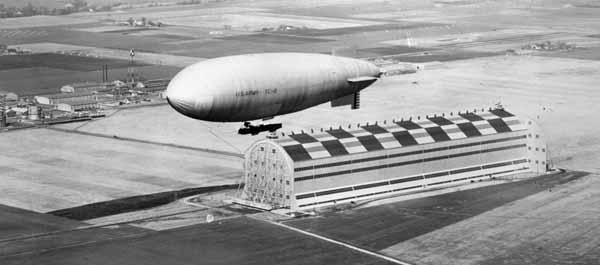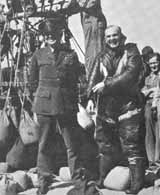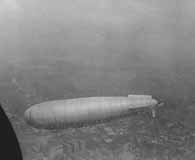Journey To Obsolescence: The Army Air Corps Lighter-Than-Air Branch – Part 2

Editor’s Note: This article is the second installment from Maj. Gen. (ret.) Neal Creighton’s Journey To Obsolescence. Please click here to read the first article from this series.
As with all other elements of the United States Armed Forces, the Armistice that marked the end of the fighting in World War I was the beginning of a rapid demobilization of the Air Service. When the Armistice was signed in November 1918, the Air Service had 190,000 people in uniform. Two months later, that number was down to 81,000. By the time 1920 arrived, over 95-percent of all the officers commissioned during the war had been discharged. However, among those remaining were some very experienced Lighter-Than-Air (LTA) balloon officers such as Chandler, Paegelow, and Jouett as well as a group of newcomers who had been attracted to this new organization that seemed to have prospects of bringing cutting edge aerial technology to 20th century warfare.
{default} Among the newcomers was Major Oscar Westover, West Point Class of 1906. Originally in the Signal Corps, he switched to the LTA service in 1921, obtaining his balloon pilot’s rating and subsequently becoming one of the first military members to participate in national and international balloon races. Jacob Wuest, a West Point classmate of Douglas MacArthur in 1903, moved from a career in the Infantry to the Balloon Service in 1917. After qualifying as a Junior Military Aviator, he was assigned to head the Fort Omaha Balloon School just prior to the end of hostilities in Europe. Another “old soldier” who opted to join the newly created Air Service was William Kepner. Kepner had enlisted in the Marines at age 16 in 1909 and later transferred to the Army where he earned an officer’s commission and served in France in 1918 as an infantry company commander. By the time World War I ended, Kepner was a battalion commander with three wounds from enemy fire. Upon return to the United States, he transferred to the Balloon Service and graduated from the Balloon School at Langley Field in 1921. Eventually Kepner would fly almost every airship in the Army’s inventory.
Among the newcomers was Major Oscar Westover, West Point Class of 1906. Originally in the Signal Corps, he switched to the LTA service in 1921, obtaining his balloon pilot’s rating and subsequently becoming one of the first military members to participate in national and international balloon races. Jacob Wuest, a West Point classmate of Douglas MacArthur in 1903, moved from a career in the Infantry to the Balloon Service in 1917. After qualifying as a Junior Military Aviator, he was assigned to head the Fort Omaha Balloon School just prior to the end of hostilities in Europe. Another “old soldier” who opted to join the newly created Air Service was William Kepner. Kepner had enlisted in the Marines at age 16 in 1909 and later transferred to the Army where he earned an officer’s commission and served in France in 1918 as an infantry company commander. By the time World War I ended, Kepner was a battalion commander with three wounds from enemy fire. Upon return to the United States, he transferred to the Balloon Service and graduated from the Balloon School at Langley Field in 1921. Eventually Kepner would fly almost every airship in the Army’s inventory.
Frank Kennedy was another experienced officer who joined the Lighter-Than-Air Service in 1918. He had originally been an airplane pilot prior to World War I, earning his wings in 1911. However, he was seriously injured in an air crash in 1912 and subsequently transferred to the Fort Omaha Balloon School as Commandant in 1918. Kennedy would end up staying with airships until 1937.
Among the junior officers who had joined the LTA Branch during World War I was Neal Creighton. Creighton, just beginning his final year of law school at the University of Southern California, volunteered for the Army the day after the United States entered the war in April 1917. Two months later he was commissioned a 1st Lieutenant in the Signal Corps and assigned to the LTA Branch. He received his balloon training at Lee Hall and was preparing to go overseas to France when the war ended. Attracted to the life style of the Army, he opted to remain in the military and soon received a Regular Army appointment as a 1st Lieutenant. As with Kennedy, Creighton, too, would remain with the Army LTA units until the very end of their existence.
Lt. O. A. Anderson, like Creighton, joined the U.S. Army shortly after the U.S. entered World War I in 1917. He went directly to the Omaha Balloon School shortly after that, but, on graduation was not posted with a balloon unit because of an excess of balloon qualified officers. However, after the war ended, he was assigned to Langley Field where he again took up his career as an Air Service flying officer. He served mainly with LTA units until 1936, often as a test pilot for airships. He also was the pilot of a balloon which established an altitude record that lasted for 21 years before it was broken in 1956.
These officers, along with Paegelow, Chandler, and Jouett, would play significant roles in trying to develop missions for LTA airships in the wars of the future.
The end of World War I was heralded by the leading politicians of the time as “The war to end all wars”, and this widely-accepted premise was to shape the size and capabilities of the U.S. Armed Forces until shortly before the beginning of World War II.
The Defense Act of 1920 authorized an Army Air Arm of 1,516 officers and 16,000 enlisted soldiers. The LTA portion of that was programmed to be stationed principally at five separate locations (Langley, Virginia; Scott Field, Illinois; Brooks Field, Texas; Fort Bragg, North Carolina; Fort Sill, Oklahoma; and Ross Field, California.) In 1922, the Balloon and Airship School was established at Scott Field. That base was designated to be the central balloon and airship depot and experimental station. In 1923, John Paegelow became the commander at Scott, a command he would hold for over ten years while becoming the face and voice of those who believed that Lighter-Than-Air had a significant role to play in future wars.
Shortly after the end of World War I, the U. S. Army undertook a study of what should be the role of its aviation forces. While there were those like General Billy Mitchell, Colonel Chandler, and Major “Hap” Arnold, who favored a separate Air Force, this was not the decision that came out of the deliberations. What did come out was that the Air Service would be designated a combat arm of the Army that would be structured to support the Cavalry, Infantry and Artillery branches. This position was supported by many experienced World War I officers including Pershing and General Mason Patrick, then the Chief of the Aviation Division.
A second controversy soon arose between the Army and Navy. During the war years, both these Services had become interested in acquiring rigid airships similar to the German-produced dirigibles. It was these very large airships that had attracted the attention of the world with long range bombings, particularly those attacks made on the United Kingdom by the German-made Zeppelins. The leader for the Army Air Service in trying to convince his superiors of such an acquisition was Colonel Chandler. The controversy was eventually decided by a joint Army-Navy board that recommended that the Navy have priority in acquiring a Zeppelin from the Germans. Shortly after the Army-Navy Board decision, Chandler retired from active duty. However, he remained a respected commentator on LTA matters throughout the remainder of his life. In retirement he became an editor of Ronald Aeronautical Press and the author of three books dealing with the history of the early years of the Army Air Service.
 After the Army acquiesced in the decision that the Navy have priority in acquiring a Zeppelin, it turned to semi-rigid airships as the solution to its search for larger airships. It then obtained permission to purchase a semi-rigid ship from the Italians. This airship, aptly named the Roma, was delivered to the U. St. in 1921 and was stationed at Langley Field for test trials. After just a few initial flights showed that the engines were underpowered, the Air Service mechanics installed new Liberty engines on the craft. On February 21, 1922, with 45 persons on board and an experienced pilot, Captain Dale Mabry, in charge of the flight, the large semi-rigid took off from Langley for a flight over the surrounding area and out over the waters of the Chesapeake Bay. While cruising smoothly at a speed of 55 miles per hour and an altitude of 600 feet, suddenly the control box at the rear of the ship broke and the nose plunged downward where it hit high voltage wires and exploded and burned. Thirty-four of those on board, including Mabry lost their lives. Officers investigating the crash could not determine the cause but many suspected that the newly installed Liberty engines were too powerful for the craft, causing it to break apart in flight. However, a significant outcome of the tragedy was that the Air Service began a transition away from the highly combustible hydrogen gas to the more expensive but safer helium to provide the lift capability for its LTA vehicles.
After the Army acquiesced in the decision that the Navy have priority in acquiring a Zeppelin, it turned to semi-rigid airships as the solution to its search for larger airships. It then obtained permission to purchase a semi-rigid ship from the Italians. This airship, aptly named the Roma, was delivered to the U. St. in 1921 and was stationed at Langley Field for test trials. After just a few initial flights showed that the engines were underpowered, the Air Service mechanics installed new Liberty engines on the craft. On February 21, 1922, with 45 persons on board and an experienced pilot, Captain Dale Mabry, in charge of the flight, the large semi-rigid took off from Langley for a flight over the surrounding area and out over the waters of the Chesapeake Bay. While cruising smoothly at a speed of 55 miles per hour and an altitude of 600 feet, suddenly the control box at the rear of the ship broke and the nose plunged downward where it hit high voltage wires and exploded and burned. Thirty-four of those on board, including Mabry lost their lives. Officers investigating the crash could not determine the cause but many suspected that the newly installed Liberty engines were too powerful for the craft, causing it to break apart in flight. However, a significant outcome of the tragedy was that the Air Service began a transition away from the highly combustible hydrogen gas to the more expensive but safer helium to provide the lift capability for its LTA vehicles.
At the time of the Armistice in 1918, the Air Service inventory of balloons did not include any motorized airships even though it had experimented with some prototypes prior to World War I. While initially pursuing the acquisition of German-made Zeppelins and then settling for the purchase of the Roma from Italy, Air Service leaders also made efforts to obtain ships from other sources. Their first two were transferred from the Navy and these were soon followed by newly constructed non-rigids built by American manufactures, including Goodyear, Goodrich and the Airship Manufacturing Company of America. These new flying machines were similar to types being developed in Europe by our former World War I allies, but they also included some innovative experiments with different types of airships, mainly smaller ones that could operate more easily to fulfill the Air Service’s mission of supporting the combat elements of the ground Army.
These smaller ships included Pony airships developed by the Goodyear Company and motorized balloons built by the Airship Manufacturing Company that could move on their own power when operating in support of artillery, infantry and cavalry units. While the Pony balloons were not a huge success because of poor flight characteristics, the motorized balloons eventually were fielded in the two balloon companies supporting artillery units at Fort Bragg and Fort Sill. The acquisition of airships, some of which were fairly large, also required the Army Air Service to construct hangers at a number of installations where they were stationed. The largest was at Scott Field and that one was deliberately built to be big enough to hold a Zeppelin. Smaller hangers were built at bases wherever balloon organizations were stationed, including Langley Field, Post Field (Ft. Sill), Pope Field (Ft. Bragg), the Panama Canal Zone, and the Philippines.
The Army Air Service LTA Branch became very active and successful participants in national and international balloon races. In 1919, the Army won first place in the national competitions and repeated this first place finish again in 1922, 1923, 1924, 1925 and 1932. Oliver Westover was the pilot of the winning balloon in 1922. Bill Kepner was the winning pilot in 1928, not only in the national competitions, but also in the international championships held in Belgium, where he was presented the trophy by King Albert. The Army Air Corps continued its participation in the international races through 1930 and the national races through 1936 although there were some mishaps along the way. In 1928, one of the two Army balloons in the national race was struck by lightning, killing one of the two crew members. In 1936, the Army entry in the national competition crashed and burned in an accident that took no loss of life but ended the Air Corps’ participation in balloon races. Over the years, however, these competitions served to provide the LTA service with a significant amount of favorable publicity.
Another venture undertaken in the 1920s was that of making high altitude research in balloons. These flights also attracted the attention of the press around the country as they became efforts to take man to new heights above the earth. The most ambitious of these efforts came in 1927, when Captain Hawthorne C. Gray was selected to make flights that would break the then existing world altitude record. He made three attempts to do this from Scott Field, the last coming on November 4 that year. Gray reached a world record height of 42,700 feet above the earth’s surface. Unfortunately, somehow he misjudged the amount of oxygen available to him and he died in the balloon’s basket after beginning his descent.
Major General, ret. Neal Creighton, whose distinguished military career included command of the U. S. 1st “Big Red One” Infantry Division, is the author of A Different Path: The Story of an Army Family (Xlibris, 2008).


I have a picture of my father Msgt. Olin Brown and Col. Creighton (all suited up in leather sheepskin flight gear)standing in the basket of a free balloon at Pope Field, N.C. circa 1940.